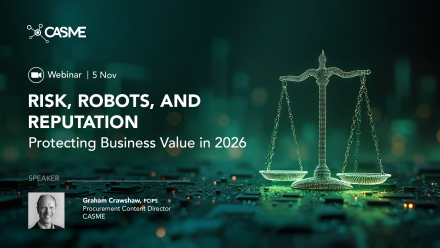
As procurement professionals across the globe grapple with cost pressures and digital transformation imperatives, AI is emerging as both an accelerant and a disruptor. In a recent CASME webinar hosted in partnership with The Hackett Group titled “Fact vs Fiction? Exploring AI’s Real Impact on Procurement”, panellists Graham Crawshaw (CASME), Nic Walden and Rizwan Imtiazi (The Hackett Group), offered a refreshingly grounded perspective on AI’s real impact beyond the hype and firmly rooted in category-level realities and member survey results.
From Concept to Capability: Where Procurement Stands
“Last year, something like 5% of teams would say they’re piloting AI; now it’s more like 60%,” observed Nic. This twelvefold increase marks a notable shift from theory to tangible experimentation. He began by setting the stage with key definitions:
- AI: a machine system that can perform tasks that typically require human intelligence, moving beyond traditional rule-based automation.
- GenAI: a type of AI that can generate new content in a human-like manner – for example, Microsoft Copilot, chatbots and agents in systems like Fairmarkit, Ivalua or SAP Joule.
- Agentic AI: a newer and more autonomous form of AI capable of decision-making, taking actions, and learning independently; for instance, autonomous driving agents (Tesla, BYD), black-box trading algorithms, and cybersecurity threat detection.
Graham then shared the results of a recent CASME survey of hundreds of procurement category managers across the globe titled “What AI is currently used for”. The findings showed four high-impact use cases where procurement teams already apply AI capabilities:
“Rather than worrying about AI taking over negotiations, let it help you prepare,” Graham advised. He explained how AI is enabling teams to model scenarios, simulate supplier behaviour, and deepen contract analysis.
However, Graham also flagged the main barriers to AI implementation: data accuracy, integration with existing systems, and the concerns about potential errors. He concluded: "You need the combination of AI with your own human intelligence to actually make sense of the information."
Where AI Has Gained Traction: The Indirect Category Lens
The discussion then shifted to AI’s practical usability in indirect procurement categories. A live audience poll revealed which categories were experiencing the most noticeable impact:
- Customer Service and Contact Centres
- Digital, IT and Telecoms
- Marketing and Advertising.
Reflecting on these results, Rizwan noted, “Marketing and Advertising has the biggest traction, but in terms of showing tangible impact within spend categories, it hasn’t quite materialised yet.”
Key Takeaway: AI adoption is progressing fastest in digitally native spend categories, while others remain less suited to AI for now. Success depends on high-quality data and targeted application, not blanket implementation. Nevertheless, the velocity of AI capability development is striking, with more capabilities and maturity to be expected soon; we are only at the start of the AI journey.
The Savings Gap: Bridging Hype and Reality
Hackett’s analysis identified the top spend categories for which AI has the greatest potential for negotiation-driven savings. IT/Digital Services led with a projected savings range of 25-47%, followed by Marketing and Customer Services, both within 22-44%. But while AI’s potential for cost reduction often dominates the headlines and consultancy and analyst predictions, real world procurement teams report a more nuanced reality.
The second live audience poll revealed:
- 31% said AI opportunities are not yet appearing
- 27% reported enhanced functionality without savings
- 18% noted savings in the 1–10% range
- 10% said that prices had actually gone up.
Key Takeaway: Nic contextualised the findings: “It’s early days. Suppliers are looking to recover their investment. Unless you’re switching vendors or leveraging a disruptor, and not running parallel applications, don’t expect overnight cost reductions. Work needs to be done in analysing and cost modelling how AI is augmenting your spend category to challenge suppliers effectively.”
Changing Procurement’s Ways of Working: The Operating Model Shift
Attention turned to the organisational impact of AI on procurement functions. As AI is becoming integral to procurement's evolution, the panel outlined productivity gains, and organisational shifts that are required to unlock AI’s full potential.
Hackett’s recommendation was to structure the Procurement AI Technology Strategy as a balance and combination of build and buy models. Purchasing ‘off the shelf’ AI in standard source to pay applications, while building bespoke solutions for the organisation’s unique data, analytics and insights requirements.
The team shared top AI use cases and vendor examples in the source to pay landscape, based on the areas that are believed to offer the greatest opportunities for AI application.
Hacket also showed where within the procurement lifecycle AI and GenAI tools can accelerate and improve activities, citing that AI can accelerate e-Sourcing, contract development and supplier management & supplier relationship management (SRM) activities by as much as 30%.
Hackett also introduced the concept of AI agents as the next frontier of the source to pay process augmentation. These agents, already being deployed across leading procurement platforms, aim to rapidly accelerate tasks, notably within supplier discovery, P2P and master data by up to 50%.
Adoption in Practice: Tool Usage and the Prompt Engineering Imperative
The panel turned to how procurement professionals are engaging with AI tools. The final poll revealed:
- Most participants had used at least one AI tool
- ChatGPT and Microsoft Copilot dominated usage
- Primary uses included general information gathering, research and productivity tasks
- Only 1% reported no usage.
Nic encouraged attendees to move beyond surface level interactions to experiment with more advanced capabilities. He recommended using AI to generate contract clauses, or conduct deep-dive analysis, explaining that these tools now have a working understanding of contract, business, and Procurement, and may deliver valuable insights and save users’ time.
Rizwan expanded on the importance of prompt engineering, explaining that structured prompting can boost productivity by up to 80%. He demonstrated how “prompt chaining” – where sequential prompts build on one another – transform basic queries into strategic outputs. Demonstrating live, he fed Copilot category data and within a minute generated a risk-aware procurement category strategy covering sustainability, demand forecasting, and stakeholder alignment.
“Don’t just use GPT for surface-level tasks,” Rizwan emphasised. “With the right prompt (asking the right question in the right way), you can build entire negotiation or category strategies – complete with spend and demand insight, risk analysis, the external factors and geopolitical changes that may impact strategies, and sustainability and stakeholder considerations. It will even generate a tabulated action plan.”
The panellists agreed that while AI can generate the first draft – even templatising answers in the requested format – every output must be sense-checked, source-checked, validated and refined by a procurement professional.
Rizwan likened AI to a “straight-A student with no business sense: if you don’t guide them precisely, they’ll hallucinate plausible sounding nonsense.”
Key takeaway: Procurement professionals must master structured prompting – not just be given access to AI tools – to unlock AI’s strategic potential.
Practical Advice for AI Integration
The panel distilled their advice into four actionable steps:
- Review embedded AI: many existing tools already offer untapped AI features (e.g., contract life cycle management (CLM) analytics).
- Prioritise prompt literacy: treat prompt engineering as a core capability.
- Adopt a hybrid approach: buy transactional tools; build insight-driven solutions.
- Enable experimentation: “This isn’t just about cost-cutting—it’s about freeing your team for more value-adding work,” urged Graham.
Global Participation and Perspectives: What the Live Chat Revealed
With over 160 participants tuning in from around the globe,including Australia, Brazil, the Czech Republic, France, India, Malaysia, the Netherlands, Singapore, Switzerland, The United Kingdom, and the United States, the global nature of indirect procurement was fully on display.
Participants questioned whether AI savings are being transparently passed on by suppliers. Others voiced concerns that suppliers might use AI to improve their delivery but retain those benefits without reducing pricing. The discussion touched on vendor accountability, urging buyers to put AI capabilities and roadmaps on the SRM and continuous improvement agenda.
Debate also emerged around the ambiguity of what constitutes AI versus automation or machine learning. Several participants noted that the term AI is often used loosely, masking traditional technologies behind new labels.
One participant captured a growing sentiment: “The key is to approach this with suppliers as a structured agenda item, ask them how they’re deploying AI, and what’s in it for you.”
Finally, the future of procurement skills took centre stage. The chat aligned with Nic and Graham’s perspectives that creativity, critical thinking, stakeholder relationships, and problem-solving will remain invaluable - the distinctly human skills that no AI can replace.
As the session closed, one message stood out in the chat: “AI is not replacing Procurement, but those using AI will replace those who are not.”
Final Word: Human Intelligence Still Reigns
Throughout the session, one theme remained constant: AI is an enhancement, not a replacement. Procurement teams bring judgement, nuance, and contextual awareness - traits that remain firmly human.
“You need the combination of AI and human intelligence to make sense of the data and drive change,” Graham concluded.
With GenAI maturing and agentic AI gaining ground, procurement teams cannot afford to wait. The tools are ready. The use cases are real. The time to act is now.
As the closing line echoed: AI won’t wait, and neither can you.
Back to News



